Beautiful tree in pencil. How to draw a tree with a pencil step by step
In this lesson you will learn how to draw trees with a pencil. The question may seem tritely simple, but in fact it is difficult, because we are trying to make it as realistic as possible. The tree does not have any clear outlines, and the many branches and leaves make the work long and difficult. We will try to create the visual effect of a realistic tree using light and shadows.
How to draw trees with a pencil step by step
Step 1. So, I will show you how to draw an oak tree. And the first thing you have to do is outline the line of the ground, draw a trunk (usually an oak tree is thick, uneven, and the branches begin to grow low) and several large branches, from which you can draw a couple more small branches.  Step 2. Then your tree needs to draw foliage and crown. This is an important point, since the shape of the crown determines the impression of the entire tree. In this picture I depicted it expanded in both directions, but you, of course, can illustrate it as you please. As for the leaves, you can make them smeared or, on the contrary, draw each leaf, it depends on what effect you want to achieve.
Step 2. Then your tree needs to draw foliage and crown. This is an important point, since the shape of the crown determines the impression of the entire tree. In this picture I depicted it expanded in both directions, but you, of course, can illustrate it as you please. As for the leaves, you can make them smeared or, on the contrary, draw each leaf, it depends on what effect you want to achieve.  Step 3. Next, we will add density to our foliage, which will make your tree more voluminous, which will give it lightness and liveliness. Here you need to take into account that the lower part of the crown is always a little darker than the upper part, which comes into direct contact with the sun's rays.
Step 3. Next, we will add density to our foliage, which will make your tree more voluminous, which will give it lightness and liveliness. Here you need to take into account that the lower part of the crown is always a little darker than the upper part, which comes into direct contact with the sun's rays. 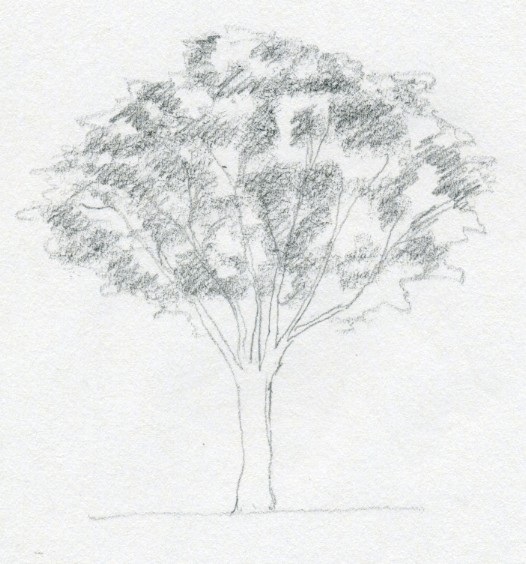 Step 4. After this, we will highlight the contours of the tree trunk and branches emanating from it, coloring them with a pencil, and also add density to the leaves around the branches.
Step 4. After this, we will highlight the contours of the tree trunk and branches emanating from it, coloring them with a pencil, and also add density to the leaves around the branches.  Step 5. And let’s add the final touch to our drawing - we’ll draw the final outline of the crown and draw a shadow under the tree. I hope now you have an idea of how to draw trees with a pencil. If you have ideas on how else you can draw a tree, write about it in the comments or. In the meantime, I have made a few more drawing lessons on landscapes especially for you. Try drawing it here.
Step 5. And let’s add the final touch to our drawing - we’ll draw the final outline of the crown and draw a shadow under the tree. I hope now you have an idea of how to draw trees with a pencil. If you have ideas on how else you can draw a tree, write about it in the comments or. In the meantime, I have made a few more drawing lessons on landscapes especially for you. Try drawing it here.
Almost always, when drawing any landscape, a tree appears as the main or additional object, and sometimes even more than one. Before you start drawing an entire grove or even a forest, you need to learn how to draw a single tree, and also practice drawing different types of trees.
In this tutorial I want to demonstrate how to paint different types of trees using different techniques. It is very important that the paints are of good quality - you can find excellent paints here http://zakupka.com/t/kraski-hudozhestvennye-8820/. Using low-quality paints will make it difficult for you to control your work with paint, and in general the whole process will not bring much pleasure, and the result will most likely be extremely mediocre.
So, I will show you how to paint a winter spruce, a deciduous tree, and also a technique for painting a tree with a sponge. Let's start.
How to paint a spruce with paints
First, let's designate the trunk. It shows in which direction the side branches grow. Important - if you paint not with gouache, but with watercolor, then you will need to make a preliminary sketch with a pencil and start painting from the light areas, then wait until the paint dries and move on to the dark details. If you don't do this, all the paint will mix and you'll end up with a very messy, unsightly painting. By the way, here is a detailed description of the technique of painting flowers with watercolors.
After you have completed the branches, we outline the main color of the coniferous foliage of the tree. In some places the paint will be a little lighter. We draw the darkest areas green with the addition of blue - you should get a sea green color.

To add snow to the spruce branches, wait until the paint is completely dry. We paint snow with white paint with the addition of a blue or light blue tint.

How to paint a deciduous tree with paints
Again, we start drawing from the trunk, from which the branches are directed as shown in the image below.

Here we will use a warmer green for the foliage - you can get this color if you add a little yellow to the usual green - this way you can adjust and change the shade. The more shades of green there are in your drawing, the more interesting the final result will look. We paint the shaded areas with dark green and turquoise.
![]()
Individual, strongly illuminated petals can be designated yellow. Don't forget to paint the trunk with dark and light shades of brown. Also draw the soil, grass and flowers at the base of the tree.

How to paint a tree with paint and sponge
This method is especially popular with children and novice artists. It will require paper, paint and a small piece of sponge or foam rubber.
We start drawing from the trunk. Using light movements using a thin brush, draw the branches.
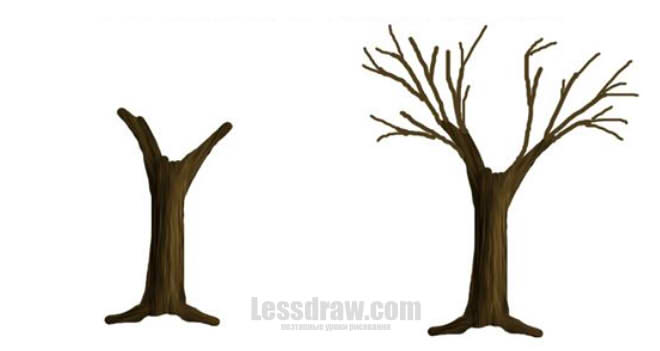
After this, you need to dip the sponge a little in green paint and carefully leave prints on the paper in the place where the tree crown should be located. You can practice on a rough draft. Adjust the amount of paint and pressure to get the best effect.
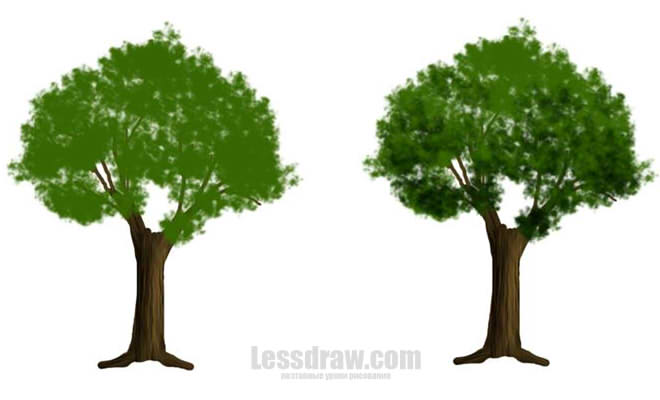
Shade the lower part of the tree crown using a sponge and dark green paint. To ensure the colors don't mix and the texture is preserved, wait until the first coat of paint dries.

We cover the upper part in the same way with light paint.

We hope that it was useful to you and you learned how to paint a tree with paints.
Before you start drawing trees step by step with your children, carefully consider these natural objects, find common features. What is characteristic of any (or almost any) tree? Of course, this is a powerful and straight barrel. The trunk is thick at the bottom, but the closer to the top, the thinner it becomes. Branches extend from the trunk in all directions. Usually the main branches are directed upwards. At the base the branches are long, closer to the top they are short. From large skeletal branches smaller branches extend in different directions, from them even smaller ones, etc. It is these small branches that form the crown of trees. The “skeleton” of the tree is ready. You can depict winter trees in this way - without foliage, just twigs.
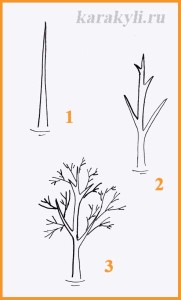
Step-by-step drawing of trees with children - a generalized scheme for drawing a tree.
We will dress the “skeleton” of the tree with leaves. You can draw them in dots, creating a mass of foliage from individual dots (tree A). When coloring foliage, it is better to take several shades of green and even yellow color for a summer tree. And for autumn - yellow, red, orange and green colors.
But it is even easier for children to depict a certain plane of an irregular shape close to an oval (tree B). This method is interesting to use when drawing with young children, or depicting trees in a landscape. In this case, first draw only the trunk and thick skeletal branches, and add small branches after painting the green area.
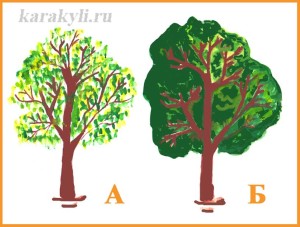
Options for drawing foliage - step-by-step drawing of trees with children
This is a tree “in general”. But of course, different types trees will be very different. And, first of all, in our drawing there will be a difference in the trunks. A thick and powerful oak-hero, a slender weeping birch with drooping branches, a rowan or a pine - compare the trunks of these trees with children.
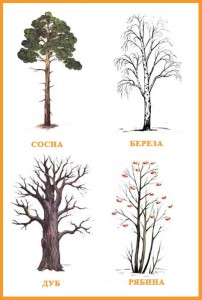
Trunks of various trees.
Help you introduce children to different tree species
A very simple tree - step-by-step drawing with children from 4 years old.
This is really a very simple way to draw a tree. Of course, it is unlikely to be able to determine its species. It is only clear that this tree is deciduous. Here we depict with the children only a trunk and a few large branches. Foliage is oval. You can color such a drawing not only with pencils and paints, but even with felt-tip pens.
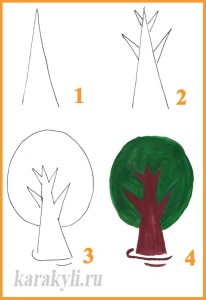
A simple deciduous tree - a step-by-step drawing scheme for children from 4 years old.
Although this tree drawing is very simple and generalized, it provides quite rich soil for creativity. See what trees you can draw based on our picture.

Tree crown design options.
Oak – step-by-step drawing of trees with children from 6 years old.
This oak tree is similar to the simple tree we drew above. But still, much more detail has been added here. This is a hollow, and the texture of the bark, and branches of complex shape. It's okay if your child leaves something out and simplifies the drawing. If his oak tree turns out to be powerful and stocky, then the artistic goal will be achieved!
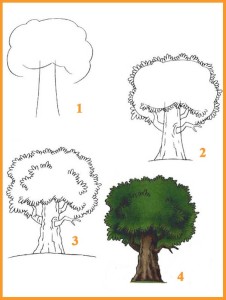
Oak - a step-by-step diagram for drawing a tree with children from 6 years old.
Birch – step-by-step drawing of trees with children from 8 years old.
Drawing such a tree for children is quite a difficult task. This image is already close to a realistic image, replete with details and complex lines. Therefore, such work is not suitable for preschoolers. And younger schoolchildren will most likely simplify this drawing. Draw the children's attention to the position of the birch branches - they are leaning down.

Birch - a step-by-step diagram for drawing a tree with children from 8 years old.
Pine – step-by-step drawing of trees with children from 6 years old.
We move from deciduous trees to coniferous trees. Remind the children that pine is an evergreen tree. Therefore, it doesn’t matter whether you draw it in a winter or summer setting - the crown will always be the same. The pine tree is drawn according to the same principle as deciduous trees, but the green needle spots need to be clearly “tied” to the branches. And the “bare” part of the trunk of this tree is much larger than that of deciduous trees.

Pine - a step-by-step diagram for drawing a tree with children from 6 years old.
Christmas tree - step-by-step drawing of trees with children from 4 years old.

Christmas tree - a step-by-step diagram for drawing a tree with children from 6 years old.
Palma – step-by-step drawing of trees with children from 7 years old.
Before this, we gave diagrams for drawing trees that grow everywhere in our country. Now let's look at the exotic palm tree. A fairly simple and decorative tree for drawing with children is a palm tree. The name “palm” comes from the Latin word “palma”, which means “palm”. Such associations were apparently born from palm leaves spread out like fingers.
We present two options for drawing this tree. The first one is more “cartoonish”, the second one is more realistic. In terms of difficulty, both drawings are approximately the same. They can be recommended for working with children aged 7-8 years.

Palm tree No. 1 – diagram of step-by-step drawing of a tree with children from 7 years old.
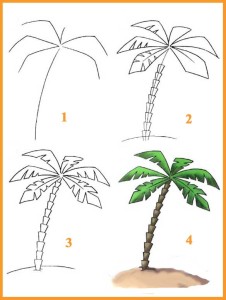
Palm tree No. 2 – diagram of step-by-step drawing of a tree with children from 7 years old.
In this drawing lesson we will look at how to draw a tree with a pencil step by step for beginners. To do this, we need pencils of different softness and an eraser with a sharp tip, or a kneader (a soft eraser that can be changed).
Let's draw such a beautiful tree.
We outline our tree in height, the location of the trunk and branches.
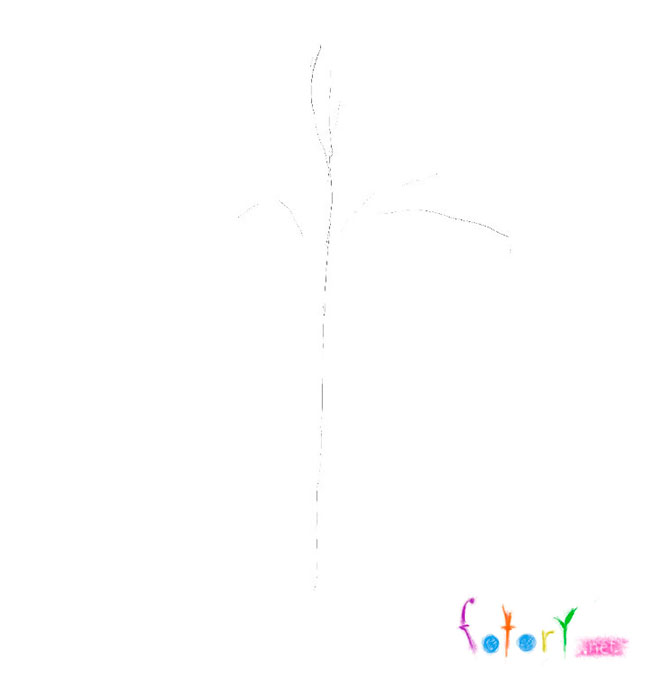
Draw the trunk, how thick it is. Please note that the trunk of the tree is not shaped like a carrot: it tapers upward gradually, and this happens largely due to the branches extending from it. As it branches, it becomes thinner. This is also true for branches - the more a branch branches, the thinner the branches become as they move away from the trunk. You should not draw a tree that is too thick at the roots - otherwise you may not have enough leaf height.

We continue to clarify the location and size of the tree branches, drawing thinner branches.
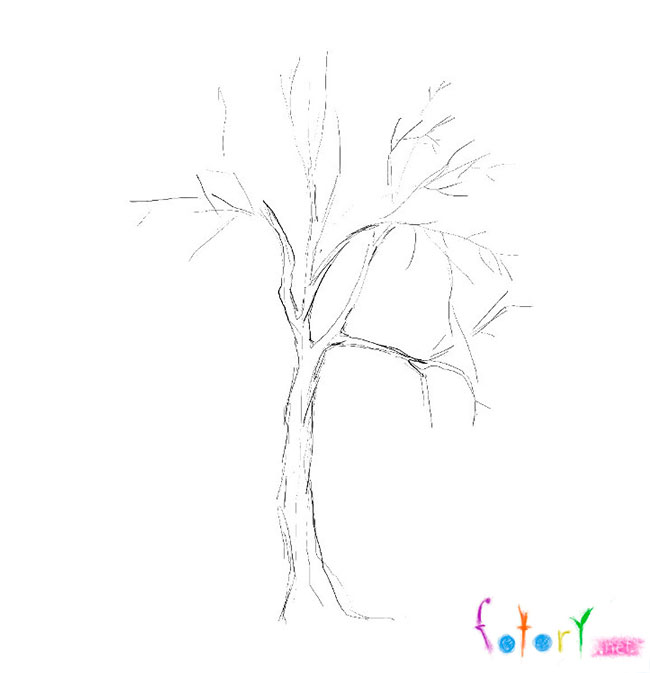
So, at the previous stage we drew a tree with branches. Now let’s trace it along the contour with a soft pencil, changing the pressure for expressiveness so that the line has different thicknesses.
But we need to draw the leaves. It is impossible to draw every leaf; you need to decide what the leaves look like in the mass. To do this, imagine that the light is coming from the side. It will be very good if you look at real trees or photographs of trees on a sunny day. It is clearly noticeable that the leaves are arranged in such large masses. Individual leaves can be drawn later, but for now let’s add shadows. There are also shadows on the tree trunk.

Apply shadows in the area of the tree foliage.

Apply the darker areas of the wood with a softer pencil. Here and there we draw thin branches using an eraser (we erase them, and we get white branches) and a pencil. In some places we draw leaves.
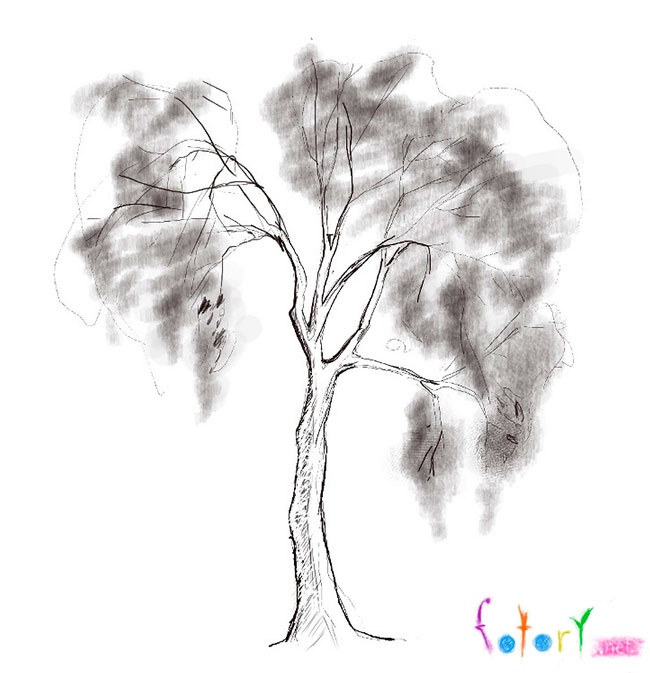
Using the same principle, we finish drawing the tree, using an eraser to highlight light areas.
Trees are an integral element of the landscape, so you definitely need to learn how to draw them. In this lesson we will look at the step-by-step drawing of birch, oak, pine, palm and other trees.
For your convenience, you may use the contents.
Let's not be verbose, because everyone knows what a tree is and what it is needed for. So, let's figure out how to draw a tree with a pencil step by step.
Drawing a birch tree
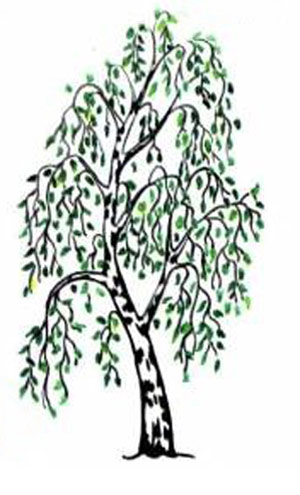
Birch is the easiest tree to draw. It’s easier to just draw a tree trunk with a pencil and outline it in green. It is drawn from curved lines; even its trunk, as a rule, is not a straight line. It is very difficult to go outside and find a birch tree with a perfectly straight trunk.
So, let's draw a birch tree step by step.
Stage 1
We will start drawing a birch tree from the trunk. As mentioned earlier, birch does not have a completely straight trunk. Therefore, we draw it a little curved.
If you are painting a landscape, then you should pay attention to the weather in your painting. If you want to depict the wind, then do not forget to tilt the birch tree in the wind. The angle of inclination depends on the strength of the wind. But despite the wind, the birch tree can be tilted at a strong angle in calm weather.
In our example, we drew the birch tree not very strongly curved. 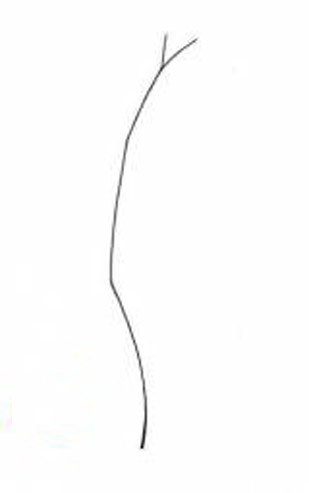
Stage 2
The second stage is nothing out of the ordinary. We just draw the trunk and be sure to leave the tips along the entire area of the trunk, the branches of our tree will grow from there. Like other normal trees, the birch trunk is much wider at the very bottom than at the top. 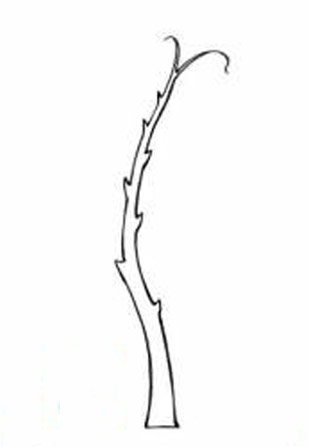
Stage 3
At the third stage we draw the branches. As with a trunk, as they lengthen they become narrower. If a branch next to the trunk is thick enough and grows upward, then it becomes thinner and hangs down, the branches must be drawn in this way, otherwise the tree will look unrealistic. 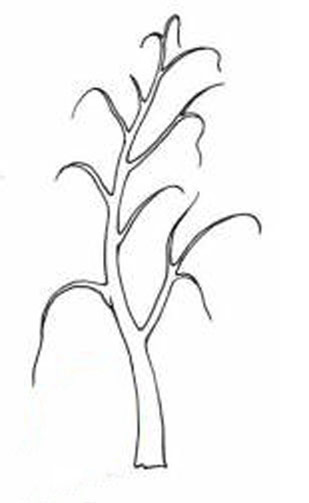
Stage 4
At this stage we draw thin branches. In most cases, they are so thin that they are unable to grow upward and simply hang down. Also, at this step we draw the bark with simple pencil strokes (or pen, or paints). 
Stage 5
If you are painting a winter landscape, then you should have finished with the birch tree at the fourth stage, but if it is summer in your painting, then we proceed to the last stage.
And this stage is not very difficult :)
We take different shades of green (this way the drawing will look more realistic) and draw leaves.
Our birch is ready and we move on to the next tree.
How to draw an oak tree with a pencil step by step?
Oak is a beautiful and massive tree. Drawing it with a pencil is a little more difficult than the birch tree that we drew above, but you will definitely succeed, and if you regularly practice drawing, then in the future you will be able to draw very, very cool trees.
Stage 1
At the first stage we will make sketches, so do not press too hard on the pencil, you will have to erase it later... We draw a hexagon as in the picture below - this is the future foliage of the tree, we also draw two sticks from below - this is the future trunk. 
Stage 2
This stage may seem very strange to you, we draw the trunk and draw absolutely uneven shapes and lines. In the future, starting from these strange lines and shapes, we will draw shadows. 
Stage 3
We put shadows on the trunk and try to depict the shadows in the foliage, namely in the uneven shapes that we drew in the previous step. 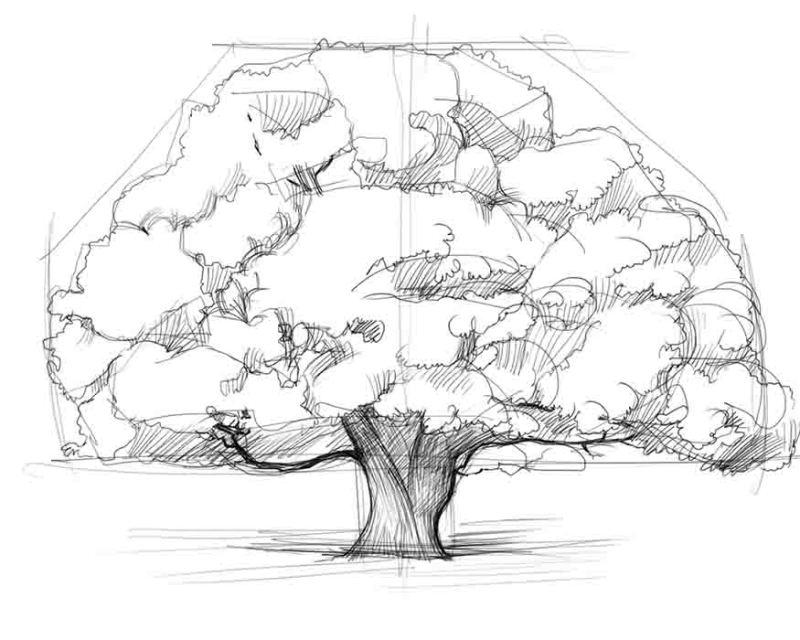
The second and third stages are very complex, although at first glance they seem very simple. Don't worry if you don't succeed the first time. Perhaps it will work out from the second or from the tenth or from the hundredth, the more you practice drawing, the faster and better you will draw.
Stage 4
This stage is much simpler than the previous ones. Here we simply draw the branches that are hidden in the oak leaves. 
Stage 5
Well, the last stage is the simplest stage. We erase all the auxiliary lines and our oak is ready.
We hope you figured out how to draw an oak tree step by step, but if you don’t succeed, don’t worry! You will definitely learn how to draw it, the main thing is to practice a lot.
Young oak
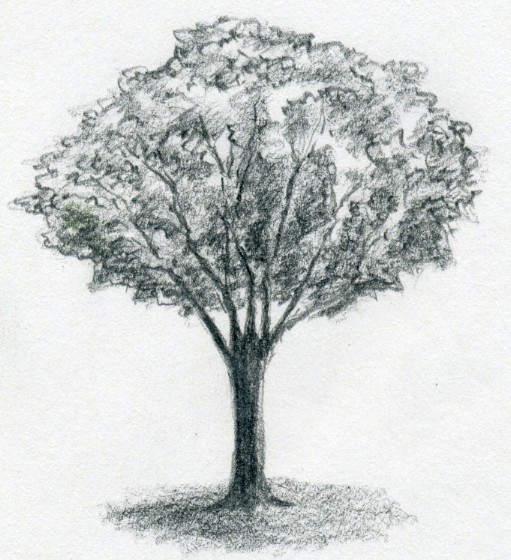
A little higher we learned how to draw an old oak tree, now it’s time to figure out how to draw a young oak tree step by step. Its drawing is very similar to drawing an old oak, but the size of the trunk and the lushness of the foliage are much smaller.
Stage 1
Draw an oak trunk and branches with a pencil. We draw the trunk not very thick, since the oak is still young. Please note that all the branches are pointing towards the sky. 
Stage 2
At the second stage we draw the foliage. To do this, you need to outline the tree with careless strokes. As a result, the width of the foliage should be slightly greater than the height. 
Stage 3
Now the very difficult steps for beginners begin. Sometimes even experienced artists encounter problems at this stage.
At the third stage we begin to draw chiaroscuro. Try to shade the foliage casually, while leaving empty spaces in some places. This may seem like an easy step, but it's not. It takes many hours of practice to get the chiaroscuro shading right, so don't worry if you don't get it right. 
Stage 4
At this stage we paint over the tree trunk and branches. Before you start painting, you need to determine which side the light will fall from and paint one part lighter than the other. In our example, the light comes from the right side, so Right side the trunk is slightly lighter than the left one.
Also, the lower part of the foliage in the branch growth area is slightly darker than the top of the foliage. This happens because less light falls there than at the top. 
Stage 5
On final stage When drawing an oak tree with a pencil, we finish drawing the foliage of the tree. We draw contours in empty places on the foliage, this will give more volume. We also shade in some places on the foliage and refine the light and shade.
That's it, the young oak is ready! This is a very difficult tree to draw, so better draw a birch forest :)
How to draw a regular tree with a pencil
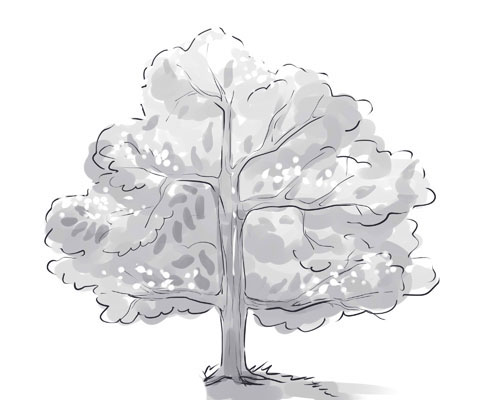
Now we will try to describe in as much detail as possible the step-by-step drawing of a tree in 15 steps. Let's start drawing!
Stage 1
We draw the trunk and outline the foliage, do not press the pencil very hard as some lines will then have to be erased. 
Stage 2
At the second stage, we draw the trunk and sketch out the future branches of the tree. 
Stage 3
At the third stage we draw the foliage on the tree. Everything is simple here, use careless rounded lines to draw something similar to the one in the picture below. If the tree will stand in windy weather, its foliage should be slightly tilted in the direction of the wind. In our example, the tree stands in calm weather. 
Stage 4
At the fourth stage, we erase the auxiliary line that we drew in the first stage and begin to detail the tree from the very bottom. We draw the first branches and use sloppy lines to depict the relief of the bark. 
Stage 5
We continue to draw the branches of the tree. 
Stage 6
We sketch the bark with sloppy lines on the surface of the entire tree. Also, at this stage we draw one branch with leaves on the left side of the tree. 
Stage 7
Using sloppy rounded lines we draw leaves on all branches of the tree. 
Stage 8
The eighth stage is also quite simple. Let's draw the earth. Of course, if you are drawing a full-fledged landscape, then in this case you need to act according to the situation. Perhaps you are painting a surreal landscape and you have trees in the air :) ![]()
Stage 9
We paint over the trunk and branches with a fairly dark pencil, or paint. 
Stage 10
Now press the pencil a little softer and paint over the left side of the tree. 
Stage 11
As in the previous stage, paint over the right side of the tree. 
Stage 12
Since the light falls on the tree from above, its top is lighter than the bottom of the tree, so we try to show this in the drawing. We paint over the lower left part of the tree, pressing the pencil a little harder than in the previous stages. 
Stage 13
Draw the leaves of the tree. You should not draw the leaves in an even row; they should be placed randomly on the branches. 
Stage 14
Since the light falls on our tree from the right from above, the right side should be lighter than the left. However, draw a little shadow under the branches, this will make the drawing look much more professional.
As mentioned earlier, chiaroscuro is very difficult, so don't worry if you don't get it right. 
Stage 15
On last stage we are drawing highlights, if you drew with a pencil, then you can just take an eraser and wash it a little :) If you painted with paints, then you will need white paint.
That's it, our tree is ready! In our example, we painted in black and white. A colored tree is drawn in the same way, it’s just that with black and white it’s easier to understand the new material.
How to draw a pine tree step by step?

It's time to learn how to draw a pine tree. We will not analyze drawing a pine tree with a pencil in very detail, since pine is an ordinary tree, we drew the same trees earlier, only pine has some features that we will analyze.
If you haven’t read about drawing previous trees, we recommend that you read it. Of course, this is not necessary :)
Stage 1
At the first stage, we draw a trunk, which, like all other trees, is thicker at the bottom than at the top. Without pressing too hard on the pencil, we outline the locations of future branches, and the top of the tree resembles the shape of an arrowhead. 
Stage 2
At the second stage we detail our pine tree. In the ovals that we drew at the previous stage we draw branches, which also have ovals and various rounded shapes similar to clouds :) We will detail these small ovals (clouds) in the next stage. 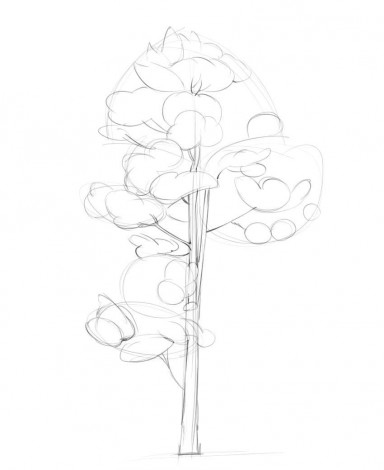
Stage 3
The third is the most difficult stage. At this stage it is necessary to detail the branches as much as possible. Although it is much simpler than it seems at first glance.
At this stage, you need to make ribbed edges instead of smooth edges, our ovals and clouds. This will be enough to make the tree look realistic. 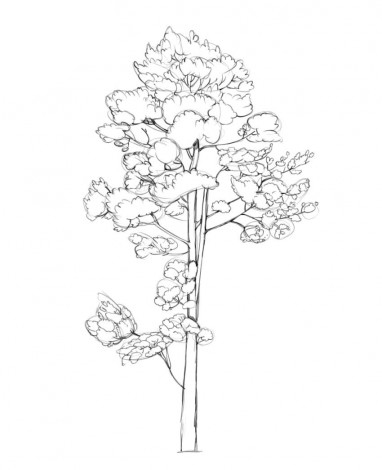
Stage 4
At the fourth stage we work on chiaroscuro.
As stated earlier, the top is lighter because light falls on it, the lower branches are darker because less light falls on them.
We draw the bark with careless lines.
The pine is ready and now we move on to our last tree for today - this is a palm tree!
Learn to draw a palm tree
If outside your window bad weather, then it’s time to draw a paradise with a palm tree, coconuts and the sea:) We won’t draw the sea in this lesson, but we will draw a palm tree and coconuts!
A palm tree is not an ordinary tree, so before you start drawing it, carefully study the result of your future work, which we present below. 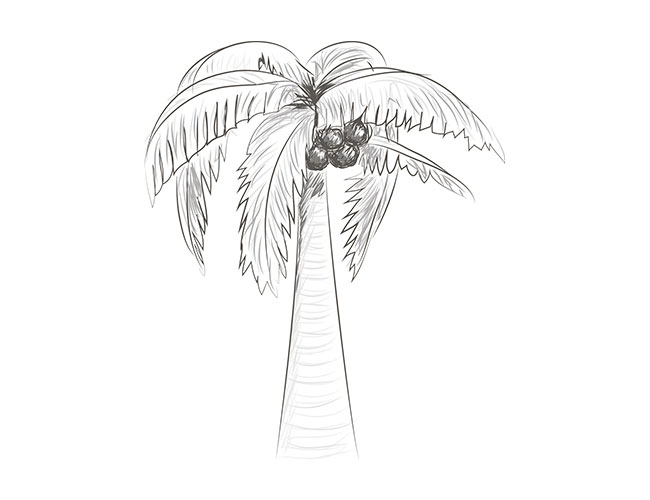
Have you looked? Now it's time to draw it.
Stage 1
At the first stage, we draw a trunk and from the tip of the trunk we make five lines directed in different directions - these are the future leaves of our palm tree. 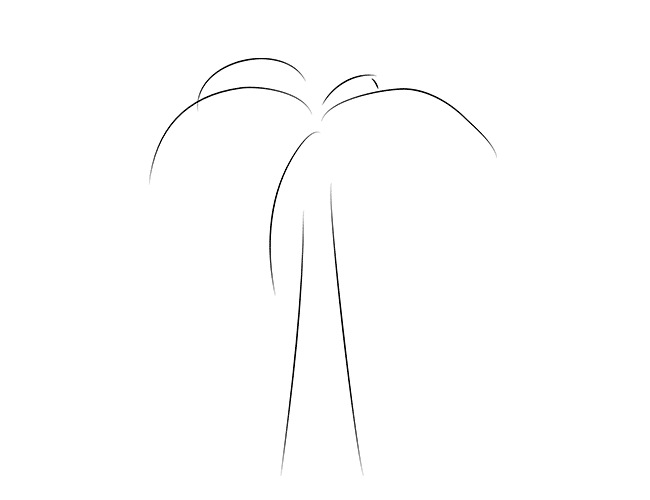
Stage 2
Now let's start drawing the palm leaves. It may seem strange to you that all the leaves are different and drawn differently, and one side of the leaf is different from the other, but don’t worry, this is all due to the laws of perspective and volume.
We outline the five lines outlined earlier, for now we will outline only the three lines closest to us.
Next to the left line, we draw another line in parallel; it will divide the sheet in half, and under the parallel line we draw inverted letters “P”.
Next to midline There is no need to draw any lines yet, since it itself divides the sheet in half. Around this line we draw sharp triangles as shown in the figure.
There is no need to draw any lines near the right line since this sheet is curved and only one part of the sheet is visible. Below the line we draw a mixture of inverted letters and triangles.
We will consider the remaining lines at another stage. 
Stage 3
At the third stage, we draw coconuts, one branch on the right and draw one leaf on the left, it grew from the top left line. 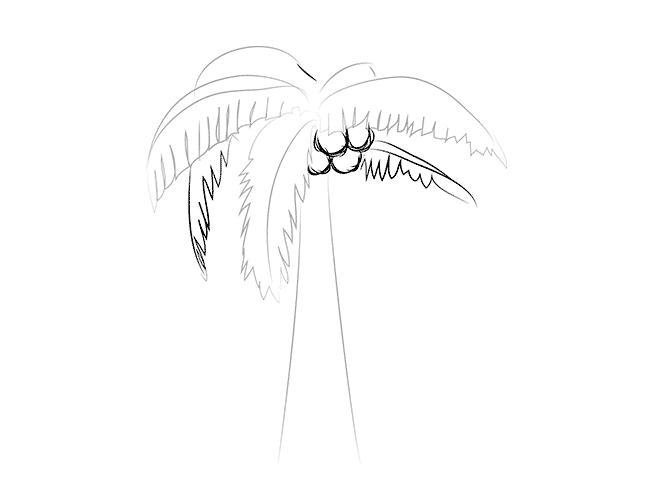
Stage 4
Now we draw the left hanging leaf and draw the leaf on the right, which grew from the upper right line. 
Stage 5
At the final stage we apply chiaroscuro. We draw textures on the trunk using rounded lines, shade the distant leaves more strongly than the front ones and our palm tree is ready! 
Let's summarize
We hope you learned how to draw a tree you like. As a result, I would like to note that if you don’t get beautiful trees or some other drawings, or if nothing works out at all, then don’t worry! Draw more and over time you will become a real artist.



















